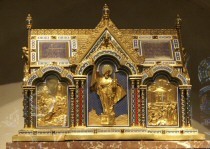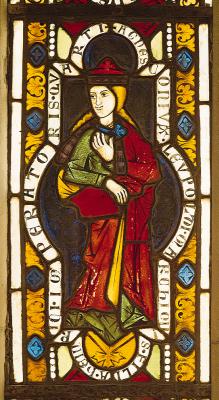
Agnes was the daughter of Emperor Henry IV from the Salian family. She was born in 1072. One of her brothers was the later German King Konrad (1074 - 1101). He reigned from 1087-1098 and died as King of Italy in Florence and is buried there. Another brother was Emperor Henry V (1086 - 1125). He reigned from 1106-1125.
As a seven year old she was engaged
At Easter 1079, Henry IV elevated the Staufer Frederick I in Regensburg to Duke of Swabia*)
and engaged him to his daughter Agnes, who was about seven years old at the time.
This Friedrich was originally called Friedrich of Büren. He built the castle on the Hohenstaufen hill around 1070,
after which the Büren family called itself "von Staufen".
They married in the year 1086/87, which established the later claim of this noble family to the German royal crown and paved the way for the historical greatness of the Staufers. In 1138 their second son Conrad III became the first king of the family.
*) In the 11th/12th century the Duchy of Swabia included half of Switzerland and Alsace (see map).
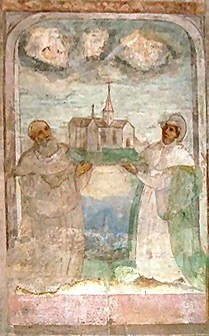
A fresco in Lorch Monastery depicts the couple who founded the monastery, the Staufer Duke Friedrich I and his wife Agnes von Waiblingen. The Benedictine monastery of Lorch was founded around 1102. The fresco is from the year 1530.
Through her brother Henry V, Agnes was related by marriage to King Henry I of England through his wife Mathilde.
Depending on the historical source, up to eleven children were born from her first marriage!
Among them:
-
Frederick II, the one-eyed, Duke of Swabia (1090 - 1147)
His son Friedrich became German Emperor as Friedrich I. Barbarossa and reigned from 1152 - 1190.
Agnes was the grandmother of Friedrich Barbarossa. -
Conrad III, (1093 in Bamberg - 1152). He was German king from 1138 - 1152 and is buried in Bamberg Cathedral.
-
Kunigunde (Kunizza). Probably she became the first wife of Duke Henry the Proud.
In second marriage he was then married to Gertrud von Supplinburg.
Frederick I. died on 6 April 1105 and was buried in Lorch Monastery, which he founded in 1102 as a Staufer burial ground.
Her second marriage
After the death of Frederick, Agnes married in 1106 the Babenberg Leopold III of Austria, who had earned this union by supporting her brother Henry V against his father. It is
said that she gave birth to eighteen children in only twelve years. Probably some of the children attributed to this union originate from the first marriage. It was Agnes who
established the close relationship between the Staufers and Babenbergers.
Some famous children of this marriage were
- Leopold IV
- Henry II Jasomirgott. His first wife was Gertrud von Supplinburg, daughter of Emperor Lothar III.
- Otto von Freising (*around 1112; † 1158). He was bishop of Freising and was one of the greatest historians of the Middle Ages
- Konrad von Passau (*around 1125; † 1168). He was bishop of Passau and later bishop of Salzburg.
Margrave Leopold died on 15 November 1136 at the age of about 60 years. The annals of the St. Peterskloster in Erfurt report that Margrave Leopold was "slain" while hunting. In a letter of consolation from Pope Innocent II to the widowed Margravine Agnes dated 8 January 1137, the Pope admonishes the Margravine and her sons to peace and harmony, the children to reverence their mother, the latter to love their children. He then informs her that he will "in accordance with her and her request" use himself with Emperor Lothar III, that he will grant "them" their right. Shortly thereafter, probably already in spring 1137, a large meeting of princes takes place in Tulln under the chairmanship of the margravine - widow, for the reconciliation of the two brothers Leopold and Adalbert. Brother Ernst is also present. Heinrich, however, the eldest son from Leopold's marriage with Agnes, is missing. Leopold remains the victor. Adalbert, however, the eldest of the brothers, an exceptionally gifted and influential personality, was excluded from the succession because he had to give way to the descendants from his father's second marriage to the emperor's daughter and sister. Agnes, however, had taken sides for her second son Leopold. The emperor and the pope also took sides for him, so that the first-born son from her marriage, Heinrich, who bore the name of the grandfather and great-grandfather, was also left behind at first. It is to be assumed that these family contrasts had a severe impact on the last years of the aging margrave's life, for neither Adalbert nor Heinrich voluntarily renounced the succession.
Her second son Leopold IV. (* 1108; † 1141) was enfeoffed with the Duchy of Bavaria, Heinrich II Jasomirgott (* 1107; † 1177) administered the estates inherited from her first husband as Count Palatine near Rhine.
Agnes died at the age of 70 on 24 September 1143 and was buried in the Augustinian canon monastery founded by her husband in Klosterneuburg.
This shrine above the famous Verdun Altar is in memory of Agnes and her husband Leopold III.
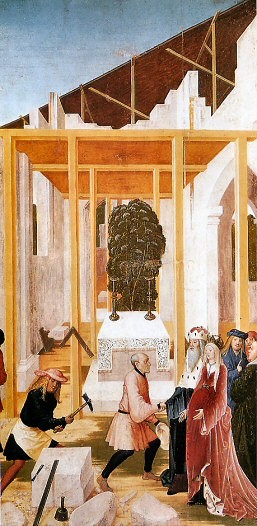
The picture shows the construction of Klosterneuburg, a panel painting by Rueland Frueauf the younger around 1505, Klosterneuburg Abbey.
In the centre of the picture the elderberry bush where Agnes' veil was found.
Agnes at Leopold's side is depicted in a state of high pregnancy. She was probably pregnant all her life, she had 29 children!
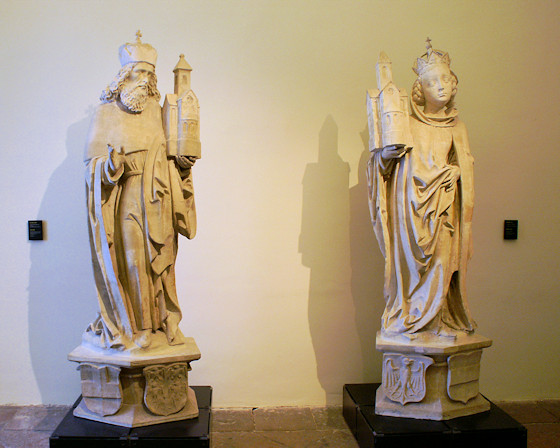
Figures of the founders of Klosterneuburg: Leopold III and his wife Agnes (museum of the monastery)
